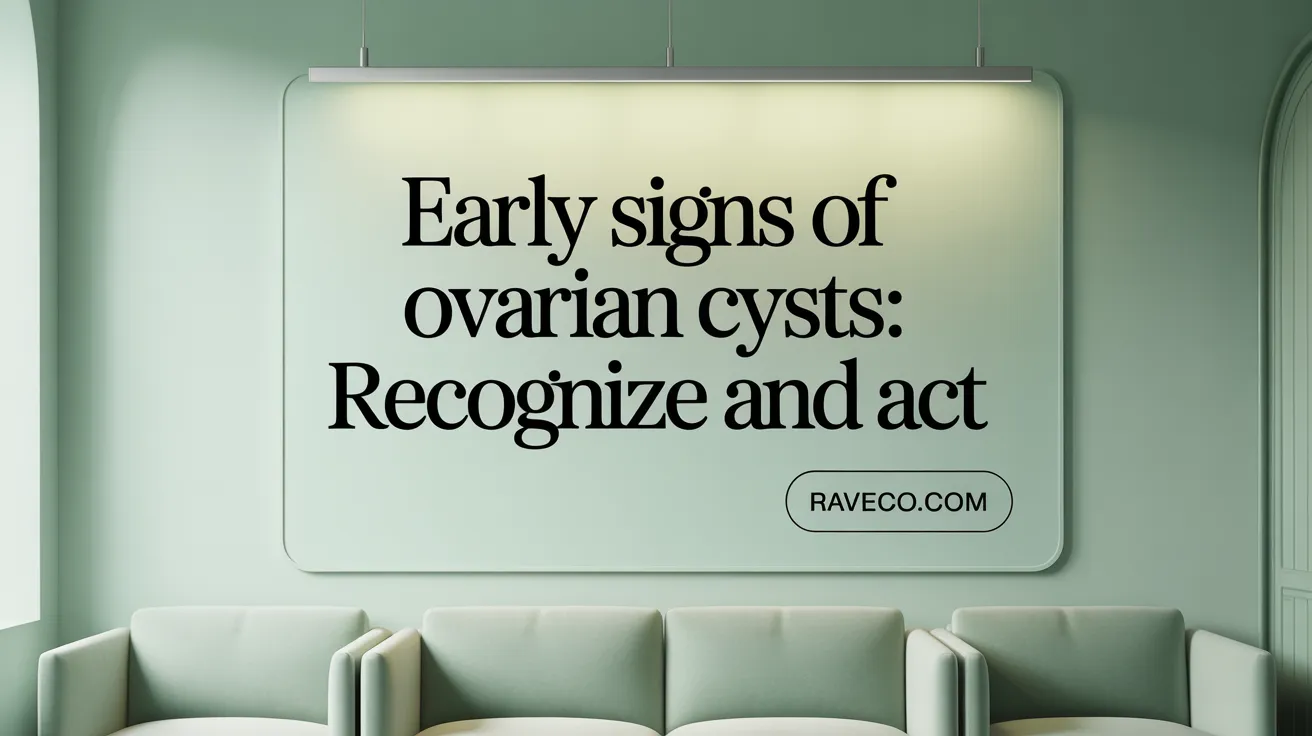Bridging Genetics and Prenatal Care: Empowering Women Through Counseling and Screening

Understanding Ovarian Cysts Through Patient Experiences
Ovarian cysts affect millions of women worldwide, ranging from harmless functional cysts to those requiring surgical intervention. While many women experience cysts without symptoms, others endure pain, complications, or even a diagnosis of ovarian cancer. Through the personal stories of women who have faced ovarian cysts, we gain valuable insights into the reality of living with this condition — the symptoms, the treatments, the challenges, and the triumphs. This article explores these narratives, offering hope and guidance to others navigating similar journeys.
Recognizing Symptoms and Seeking Diagnosis: Women’s Early Experiences

What symptoms led women to seek medical help for ovarian cysts?
Women often noticed symptoms including pelvic pain, abdominal fullness or bloating, urinary urgency, irregular menstrual cycles, and sometimes a palpable lump or mass in the abdomen. For example, Paula experienced a pressing need to urinate frequently and felt a lump in her stomach, which prompted her to consult a doctor (Paula Cann's symptoms). Other women reported persistent bloating and stomach pain, symptoms that may overlap with both ovarian cysts and ovarian cancer, underlining the importance of symptom awareness (Symptoms of ovarian cysts, Ovarian Cancer Symptoms).
How are ovarian cysts diagnosed?
Diagnosis commonly begins with a pelvic examination followed by imaging tests such as transvaginal ultrasound, which provides detailed visualization of cyst size, type, and location (Pelvic ultrasound for ovarian cysts). Blood tests, including the CA125 marker, aid in assessing the risk of malignancy (CA125 blood test and scan. In some cases, diagnostic laparoscopy is performed, allowing direct inspection of the ovaries and the opportunity for immediate treatment if needed (Laparoscopy in ovarian cyst diagnosis). These methods collectively help doctors differentiate between benign and potentially cancerous cysts (Ovarian cyst diagnosis methods, Diagnostic Tools for Ovarian Cancer).
Why is early detection important?
Early diagnosis enables timely intervention, which can prevent complications like cyst rupture or ovarian torsion and improve treatment outcomes in cases of malignancy (Importance of Early Diagnosis in Ovarian Cancer. Many women benefiting from early detection report that prompt medical attention helped preserve their health and fertility (Early detection and treatment. Stories like Paula’s highlight that recognizing early symptoms and getting timely medical evaluations are critical steps toward successful treatment and recovery (Ovarian Cancer Treatment Options.
Personal experiences emphasize symptom awareness
Women’s testimonials share how noticing initial symptoms led to crucial diagnoses (Ovarian Cancer Patient Stories. These stories inspire vigilance for uncommon signs such as sudden pelvic pain or urinary changes (Paula Cann's symptoms, Symptoms of ovarian cysts. Encouraging regular medical check-ups and attention to body changes reinforces the value of early detection and enhances women’s chances for positive health outcomes (Routine Checks and Imaging.
Navigating Treatment: From Watchful Waiting to Surgical Intervention

What treatment options are available for ovarian cysts?
Most ovarian cysts are benign and resolve independently, so the initial approach usually involves watchful waiting for ovarian cysts. This method includes periodic ultrasounds to monitor cyst size and characteristics, especially in asymptomatic cases. Hormonal therapies, such as birth control pills, may be prescribed to prevent the formation of new cysts but do not shrink existing ones. Surgery becomes necessary when cysts are large, persist over time, cause symptoms like pain or pressure, or show suspicious features raising concerns for cancer.
What types of surgical interventions are used for ovarian cysts?
Surgical treatments for ovarian cysts include laparoscopy and laparotomy. Laparoscopy is a minimally invasive procedure using small incisions and specialized instruments, resulting in less pain and faster recovery, often allowing patients to go home the same day or next day. Laparotomy involves a larger abdominal incision and is typically reserved for large, complex, or potentially malignant cysts, requiring a longer hospital stay and recovery period.
How do hormones and medications fit into treatment?
Hormonal birth control pills help regulate ovulation cycles to reduce the risk of functional ovarian cysts. Pain management using over-the-counter medications helps alleviate symptoms but does not affect cyst resolution. In certain cases, treatment of underlying conditions like endometriosis or PCOS with medication can reduce cyst formation.
When is surgery necessary?
Surgery is considered when cysts are larger than typical, cause significant symptoms such as severe pain or pressure, are persistent without shrinking, or have features suspicious for malignancy, especially in postmenopausal women. Emergency surgery may be required if complications like cyst rupture or ovarian torsion occur. More information on management of ruptured ovarian cyst and risks associated with ovarian cyst surgery is available.
How do surgical treatments impact recovery and fertility?
Laparoscopic surgery offers a quicker recovery time, less discomfort, and smaller scars, with most patients resuming normal activities within days. Laparotomy requires longer recovery, sometimes up to 12 weeks. Fertility preservation is prioritized; usually, only the cyst or one ovary is removed, minimizing impact on reproductive function. However, removal of both ovaries causes early menopause and infertility, though assisted reproductive technologies such as egg donation are available. See more on fertility preservation in ovarian cyst treatment.
This range of treatment options ensures personalized care based on cyst type, size, symptoms, and patient fertility goals, aiming for effective management with minimal disruption to quality of life.
Personal Stories of Resilience: Paula, Linda, and Janice Share Their Journeys

What challenges did patients face during their ovarian cyst or cancer treatment?
Patients faced a spectrum of physical and emotional challenges during their ovarian cyst or cancer treatment journey. Paula experienced symptoms such as urinary urgency and a noticeable abdominal lump, which led to the discovery of a large ovarian cyst that was cancerous. She underwent a full hysterectomy and chemotherapy with six rounds of chemotherapy but was able to retain most of her hair and manage side effects like nausea, with the help of supportive care.
Linda encountered a challenging diagnosis of stage 1C clear cell ovarian carcinoma. Her treatment involved laparoscopic hysterectomy and ovary removal, extensive testing, and ongoing monitoring through PET scans and imaging. Her story underscores the difficulty of treating this aggressive cancer type and highlights the crucial role of patient self-advocacy and persistence in achieving good outcomes.
Janice’s experience spanned many years with persistent, painful large ovarian cysts and several surgeries, including the removal of an ovary and later a hysterectomy due to cancer concerns. She also endured cancer scares, which compounded the emotional toll. Janice's journey emphasizes the importance of being attentive to bodily signals and the value of sustained family support.
How did support systems influence patient recovery?
Strong support systems played an integral role in helping these women navigate the physical and emotional hardships of their conditions. Paula credited her family and healthcare team for their unwavering support, which was vital to her recovery and return to health.
Janice highlighted the significance of her husband and mother’s encouragement, which helped sustain her through multiple surgeries and recovery phases.
Additionally, access to specialist nursing and supportive communities, such as those provided by organizations like Target Ovarian Cancer, offered both practical guidance and emotional solidarity. These networks create a foundation of hope and resilience that patients draw upon during their treatment.
These personal stories reveal not only the diverse challenges faced but also the powerful impact of compassionate care and strong social support in overcoming ovarian cysts and cancer.
Managing Symptoms and Relief: Home Remedies and Medical Guidance

What home remedies help alleviate ovarian cyst symptoms?
Many women find relief from ovarian cyst discomfort through simple home care methods. Over-the-counter nonsteroidal anti-inflammatory drugs (NSAIDs) such as ibuprofen or acetaminophen can effectively reduce pain and inflammation associated with cysts. Applying heat through heating pads or warm baths helps soothe cramps and pelvic pain by relaxing tense muscles. For more details, see Home treatments for ovarian cyst symptoms.
Relaxation techniques, including gentle massage and stress-reducing activities, may also ease discomfort. Nutritional support can play a role; for instance, snacking on magnesium-rich almonds might help alleviate cramping. Some turn to herbal remedies like chamomile tea, ginger tea, dong quai, and black cohosh, although scientific evidence supporting their effectiveness in treating cyst symptoms remains limited and should be approached cautiously. For additional information, refer to Managing ovarian cyst pain and Home remedies for ovarian cyst symptoms.
Why is medical consultation still crucial despite home remedies?
While these home remedies help manage symptoms, they do not address the cysts themselves or prevent potential complications. It is important to seek prompt medical attention if symptoms worsen or new signs arise—such as sudden, severe abdominal pain, heavy vaginal bleeding, nausea, fever, or symptoms suggestive of ovarian torsion or cyst rupture. These conditions can be emergencies requiring immediate care. See more on Risks associated with ovarian cyst rupture and When to seek medical attention for ovarian cysts.
Regular consultations allow health professionals to monitor cyst progression via ultrasound and other diagnostics. This vigilance helps detect when cysts grow large, persist, or display suspicious features that might signify malignancy or necessitate surgical intervention. For a thorough overview of diagnosis and treatment, visit Ovarian cyst diagnosis and treatment and Ovarian cyst treatment options. Ultimately, combining symptom management with professional medical guidance offers the best approach for safely managing ovarian cysts and preserving health.
The Journey Beyond Cysts: When Ovarian Cancer Emerges
How can ovarian cysts relate to ovarian cancer?
Most ovarian cysts are benign and common, often resolving naturally without intervention. However, some ovarian cyst types—such as cystadenomas, dermoid cysts, and endometriomas—may carry a risk of developing into borderline tumors or malignant ovarian cancer. Persistent, enlarging, or complex cysts especially in postmenopausal women require vigilant monitoring since they have an increased likelihood of malignancy.
Diagnostic tools like CA125 blood tests and advanced imaging, including ultrasound, and MRI are critical for early detection of suspicious cysts. Elevated CA125 levels, combined with cyst characteristics from imaging, guide clinicians in determining when further evaluation or surgical removal is necessary.
What are patient experiences with ovarian cancer diagnosis and treatment?
Patients often report vague symptoms such as bloating, abdominal pain, and urinary urgency, which can delay diagnosis of ovarian cancer. Some cases are discovered incidentally during routine checks and imaging.
Treatment commonly combines surgery for ovarian cancer to remove ovarian tumors with chemotherapy for ovarian cancer regimens, including drugs like carboplatin and taxol. Targeted therapies such as PARP inhibitors for ovarian cancer are increasingly used to improve outcomes. Genetic testing for BRCA mutations plays an important role in tailoring treatment and assessing familial cancer risk.
Stories from survivors like Paula Cann, Linda G., and Emma illuminate the journey through ovarian cancer. Early detection allowed Paula to undergo surgery and chemotherapy effectively, while Linda's laparoscopic surgery and personalized follow-up avoided chemotherapy despite her diagnosis. Emma's experience highlighted symptom vigilance and rapid intervention following cyst progression to cancer.
These patients additionally emphasize the importance of emotional support for ovarian cancer patients, role of family and friends in cancer recovery, patient advocacy, and persistence in pursuing timely diagnosis and care. Their resilience offers hope and awareness for others navigating similar challenges.
Finding Strength Through Shared Experiences
The stories of women living with ovarian cysts and their journeys toward relief underscore the complexity and variability of this condition. From symptom onset to diagnosis, diverse treatment strategies, and the emotional resilience required, these testimonials provide invaluable insights. They highlight the importance of early detection, personalized medical care, ongoing support, and informed self-advocacy. For those affected, knowing they are not alone and accessing appropriate care can make all the difference in managing ovarian cysts and, in some cases, overcoming ovarian cancer.





.png)